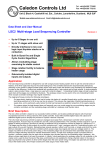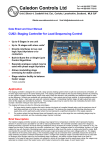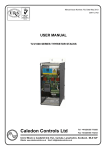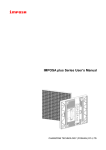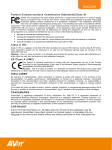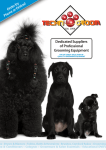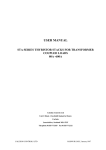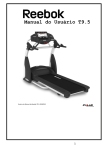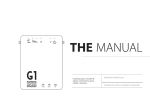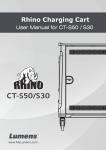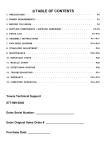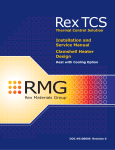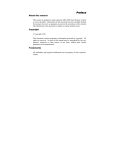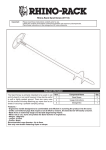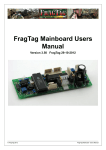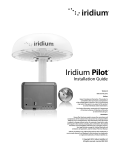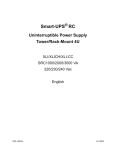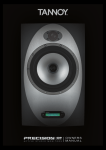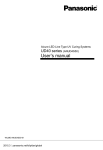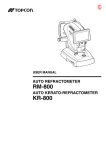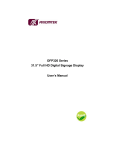Download SRC Series User Manual
Transcript
Manual Issue Number R4, Date; May 2004 p034L1r4pdf.lwp USER MANUAL SRC SERIES THYRISTOR STACKS FOR RESISTIVE LOADS, 315-800A IMPORTANT This manual applies to stacks in the SRC range which are rated above 300A. Units of lower current rating may have different terminal number assignments from those shown in this manual Caledon Controls Ltd Tel +44 (0)1555 773355 Fax +44 (0)1555 772212 Unit 2 Block 4, Castlehill Ind. Est., Carluke, Lanarkshire, Scotland, ML8 5UF Website www.caledoncontrols.co.uk Email [email protected] User Manual SRC Series Thyristor stacks for Resistive Loads, 315-800A REVISION HISTORY R1 R2 R3 R4 First issue April 2001 September 2002 Corrects errors in the fuse type table for 600A and 800A units. Adds improved instructions for removal and replacement of end contact fuse types November 2003 May 2004 Details of new driver card shelf. Updated dimensional drawing Corrected error in terminal function list; table page 13, B1, B2, B3 incorrectly assigned. Caledon Controls Ltd. Page 2 User Manual SRC Series Thyristor stacks for Resistive Loads, 315-800A Table of Contents REVISION HISTORY . . . . . . . . . . . . . . . . . . . . . . . . . . . . . . . . . . . . . . . . . . . . . . . . . . . . . . . . . . . Page 2 CONTACTING US . . . . . . . . . . . . . . . . . . . . . . . . . . . . . . . . . . . . . . . . . . . . . . . . . . . . . . . . . . . . . . Page 4 FEATURES . . . . . . . . . . . . . . . . . . . . . . . . . . . . . . . . . . . . . . . . . . . . . . . . . . . . . . . . . . . . . . . . . . . . Page 5 GENERAL DESCRIPTION . . . . . . . . . . . . . . . . . . . . . . . . . . . . . . . . . . . . . . . . . . . . . . . . . . . . . . Page 5 SRC 1000 Series . . . . . . . . . . . . . . . . . . . . . . . . . . . . . . . . . . . . . . . . . . . . . . . . . . . . . . . . . . Page 5 SRC 2000 Series . . . . . . . . . . . . . . . . . . . . . . . . . . . . . . . . . . . . . . . . . . . . . . . . . . . . . . . . . . Page 5 SRC 3000 Series . . . . . . . . . . . . . . . . . . . . . . . . . . . . . . . . . . . . . . . . . . . . . . . . . . . . . . . . . . Page 5 Current Ratings and Approximate Dimensions (height x width x depth) . . . . . . . . . . . . . . . . . . . . . . . . . . . . . . . . . . . . . . . . . Page 6 ORDERING INFORMATION . . . . . . . . . . . . . . . . . . . . . . . . . . . . . . . . . . . . . . . . . . . . . . . . . . . . . Page 6 SPECIFICATIONS . . . . . . . . . . . . . . . . . . . . . . . . . . . . . . . . . . . . . . . . . . . . . . . . . . . . . . . . . . . . . Page 6 Physical . . . . . . . . . . . . . . . . . . . . . . . . . . . . . . . . . . . . . . . . . . . . . . . . . . . . . . . . . . . . . . . . . . Page 6 Environmental . . . . . . . . . . . . . . . . . . . . . . . . . . . . . . . . . . . . . . . . . . . . . . . . . . . . . . . . . . . . . Page 6 Electrical . . . . . . . . . . . . . . . . . . . . . . . . . . . . . . . . . . . . . . . . . . . . . . . . . . . . . . . . . . . . . . . . . Page 6 Control Signal Inputs and Outputs . . . . . . . . . . . . . . . . . . . . . . . . . . . . . . . . . . . . . . . . . . . Page 7 Analogue input card . . . . . . . . . . . . . . . . . . . . . . . . . . . . . . . . . . . . . . . . . . . . . . . . . . . Page 7 LED Indicators . . . . . . . . . . . . . . . . . . . . . . . . . . . . . . . . . . . . . . . . . . . . . . . . . . . . . . . Page 7 Compliance with Standards . . . . . . . . . . . . . . . . . . . . . . . . . . . . . . . . . . . . . . . . . . . . . . . . . Page 7 European Low Voltage Directive . . . . . . . . . . . . . . . . . . . . . . . . . . . . . . . . . . . . . . . . Page 7 Electromagnetic Compatibility . . . . . . . . . . . . . . . . . . . . . . . . . . . . . . . . . . . . . . . . . . Page 7 SAFETY INFORMATION . . . . . . . . . . . . . . . . . . . . . . . . . . . . . . . . . . . . . . . . . . . . . . . . . . . . . . . . Page 8 TABLE OF SEMICONDUCTOR FUSE TYPES – CHANGING THE FUSES . . . . . . . . . . . . . . . . . . . . . . . . . . . . . . . . . . . . . . . . . . . . . . . . . . . . . . Page 8 Blade Contact Types . . . . . . . . . . . . . . . . . . . . . . . . . . . . . . . . . . . . . . . . . . . . . . . . . . . . . . . Page 8 End Contact Types . . . . . . . . . . . . . . . . . . . . . . . . . . . . . . . . . . . . . . . . . . . . . . . . . . . . . . . . Page 8 INSTALLATION . . . . . . . . . . . . . . . . . . . . . . . . . . . . . . . . . . . . . . . . . . . . . . . . . . . . . . . . . . . . . . . Page 10 General Requirements . . . . . . . . . . . . . . . . . . . . . . . . . . . . . . . . . . . . . . . . . . . . . . . . . . . . Page 10 Mounting . . . . . . . . . . . . . . . . . . . . . . . . . . . . . . . . . . . . . . . . . . . . . . . . . . . . . . . . . . . . . . . . Page 11 Cover Removal and Replacement . . . . . . . . . . . . . . . . . . . . . . . . . . . . . . . . . . . . . . . . . . Page 11 Typical Wiring Schematics . . . . . . . . . . . . . . . . . . . . . . . . . . . . . . . . . . . . . . . . . . . . . . . . . Page 12 Recommended Power Cable Sizes . . . . . . . . . . . . . . . . . . . . . . . . . . . . . . . . . . . . . . . . . Page 13 Power Cables and Access to the Load Terminals . . . . . . . . . . . . . . . . . . . . . . . . . . . . . . . . . . . . . . . . . . . . . . . . . . . . . . . . . . . . . . . . Page 13 Signal and Auxiliary Connection Terminals . . . . . . . . . . . . . . . . . . . . . . . . . . . . . . . . . . . Page 14 Terminal Function List . . . . . . . . . . . . . . . . . . . . . . . . . . . . . . . . . . . . . . . . . . . . . . . . Page 14 Auxiliary Line Connections . . . . . . . . . . . . . . . . . . . . . . . . . . . . . . . . . . . . . . . . . . . . Page 15 Fan and Analogue Input Card Supply Connection . . . . . . . . . . . . . . . . . . . . . . . . . . . . . . . . . . . . . . . . . . . . . . . . . . . Page 15 Control Cables . . . . . . . . . . . . . . . . . . . . . . . . . . . . . . . . . . . . . . . . . . . . . . . . . . . . . . Page 15 Logic Inputs . . . . . . . . . . . . . . . . . . . . . . . . . . . . . . . . . . . . . . . . . . . . . . . . . . . . . . . . . Page 15 Analogue Inputs . . . . . . . . . . . . . . . . . . . . . . . . . . . . . . . . . . . . . . . . . . . . . . . . . . . . . Page 16 Fuse Failure Indication and Output Signal . . . . . . . . . . . . . . . . . . . . . . . . . . . . . . . . . . . . . . . . . . . . . . . . . . . . . . . . . . . . . . Page 17 BRIEF NOTES ON OPERATION . . . . . . . . . . . . . . . . . . . . . . . . . . . . . . . . . . . . . . . . . . . . . . . Page 17 Cover . . . . . . . . . . . . . . . . . . . . . . . . . . . . . . . . . . . . . . . . . . . . . . . . . . . . . . . . . . . . . . . . . . . Page 17 Demand Signal . . . . . . . . . . . . . . . . . . . . . . . . . . . . . . . . . . . . . . . . . . . . . . . . . . . . . . . . . . . Page 17 Logic Control Signal . . . . . . . . . . . . . . . . . . . . . . . . . . . . . . . . . . . . . . . . . . . . . . . . . . . . . . Page 17 Analogue Control Signal . . . . . . . . . . . . . . . . . . . . . . . . . . . . . . . . . . . . . . . . . . . . . . . . . . . Page 17 Fuse Failure Indication . . . . . . . . . . . . . . . . . . . . . . . . . . . . . . . . . . . . . . . . . . . . . . . . . . . . Page 18 FAULT FINDING . . . . . . . . . . . . . . . . . . . . . . . . . . . . . . . . . . . . . . . . . . . . . . . . . . . . . . . . . . . . . . Page 19 Caledon Controls Ltd. Page 3 User Manual SRC Series Thyristor stacks for Resistive Loads, 315-800A CONTACTING US Please feel free to contact us if you require further information or advice on the application, installation or maintenance of these units. If in doubt - ask! We can be contacted by telephone, e-mail, fax or letter. Contact information is on the front page of the manual. If you have a query regarding a specific unit, please let us know the model number and serial number of the unit when you contact us. Figure 1 - Mounting Dimensions v Allow 100mm For Airflow Allow 15mm For Unclipping Line 2 Semiconductor Fuse Semiconductor Fuse Logic Card 1 Logic Card 2 H1 X = 8mm (1 and 2-phase units, 13mm on 3-phase units Line 1 Analogue Input Card H2 X defines correct position of fixing screw to allow unclipping of the bracket. Top Mounting Bracket a X Load 2 Bottom Mounting Bracket v Allow 100mm For Airflow W W The drawing above shows the SRC2000 600 / 800A model. Dimensions of all models are as shown below Model SRC1000 SRC2000 SRC3000 Overall Width Fixing Centres Body Height Fixing Centres Height inc. Clamp W w H1 H2 H3 138mm 263mm 390mm 86mm 211mm 336mm 435mm 435mm 435mm 471mm 471mm 477mm 495mm 495mm 513mm Caledon Controls Ltd. Depth 265mm Page 4 User Manual SRC Series Thyristor stacks for Resistive Loads, 315-800A FEATURES Space saving compact, slimline design Robust conservatively rated construction Long life ball bearing fans Built in EMC filters Built in semiconductor fuses Logic or analogue control input options Fuse / Phase failure alarm output GENERAL DESCRIPTION This is a modern range of thyristor stacks, specifically designed for burst fire control of resistive loads in medium and high current heating applications for furnaces, ovens, dryers etc. These units use a proven MOSFET driver circuit, and feature closely controlled zero-voltage switch on, and low crossover commutation noise. The standard input is a logic signal, but an optional analogue input driver card is available which accepts 0-5V, 1-5V, 0-10V (and 0-20mA, 4-20mA with 250 ohm burden resistor). The stacks have generously sized heatsinks and power semiconductors to ensure long term reliability. The power connections are to stud terminals, which are reliable at elevated temperatures, and under conditions of temperature cycling. The line to line EMC filter capacitors, ensure very low conducted emissions, and together with the MOV and snubber protection, contribute to very high immunity to conducted interference. The top and bottom removable mounting clips help simplify installation and subsequent removal for maintenance if required. The covers enclose both power and signal connections to protect against accidental contact. The width of the units has been kept small to simplify side by side mounting in multi-zone applications. SRC 1000 SERIES Single phase units for higher current applications from 250A to 800A SRC 2000 SERIES These units feature two independent controllers, and may be used for two line control of a 3-phase 3-wire load (without neutral connection) either star or delta connected, or alternatively for two independent single phase loads. The slimline design minimises the installed space requirement, particularly useful in multi-zone applications. SRC 3000 SERIES A range of 3-phase units, which may be used to control 3 single phase loads, or a single 3-phase load, either 3-wire star or delta, or 4-wire star connected. Caledon Controls Ltd. Page 5 User Manual SRC Series Thyristor stacks for Resistive Loads, 315-800A CURRENT RATINGS AND APPROXIMATE DIMENSIONS (HEIGHT X WIDTH X DEPTH) Allow 100mm above and below the stack for ventilation, in addition to the height dimension in the table, and 15mm between units. The fixing clamps at top and bottom of the stack extend 40mm above and below the height dimensions in the table, but within the 100mm ventilation allowance (see figure 1). Current Rating SRC 1000 Dimensions and approximate weight SRC 2000 Dimensions and approximate weight SRC 3000 Dimensions and approximate weight 315A 435mm x 136mm x 265mm 435mm x 262mm x 265mm 435mm x 388mm x 265mm 400A 435mm x 136mm x 265mm 435mm x 262mm x 265mm 435mm x 388mm x 265mm 600A 435mm x 136mm x 265mm 435mm x 262mm x 265mm 435mm x 388mm x 265mm 800A 435mm x 136mm x 265mm 8kg 12kg 435mm x 262mm x 265mm 15kg 23kg 435mm x 388mm x 265mm 23kg 34kg ORDERING INFORMATION The stacks may be ordered using the order code shown below, or by description:Type Current Rating Voltage Rating Fan Supply Voltage AC 50/60 Hz Analogue Input Options SRC1000, SRC2000, SRC3000 From table above 250V, 440V, 480V, 660V* 115V, 230V See below The standard stack is supplied with logic inputs. Optionally an analogue input card may be fitted, which converts analogue input signals to logic signals and provides 1 or 2 analogue inputs. On 3-phase models two cards may be fitted to provide 3 analogue inputs. Specify your requirements and the card(s) will be pre-wired by us to the logic inputs. This card also provides a relay which interfaces to the fuse failure transistor outputs to provide a volt free changeover contact suitable for use with higher voltages. SPECIFICATIONS PHYSICAL Dimensions and approximate weights See table and figure 1 ENVIRONMENTAL Ambient Operating Temperature Storage Temperature Relative Humidity Pollution (IEC 664) Elevation 0-50OC (800A units 0-45OC) at rated current -25OC to +70OC 0-95% non condensing Degree 2 (Only non conductive pollution is allowed. Temporary condensation may occur, but not normally while equipment is operating). Derate current rating 1% per 100 metres above 200 metres ELECTRICAL Rated Supply Voltage (Load) Caledon Controls Ltd. 250V, 440V, 480V, 660V* +10%, -25% Page 6 User Manual SRC Series Thyristor stacks for Resistive Loads, 315-800A Rated Current Supply Frequency Rated Impulse Withstand Voltage Fan supply voltage As ordered. Rated current is specified at 50OC ambient temperature except 800A unit (45OC) 50Hz or 60Hz !8% (IEC 664) 4KV 115 or 230V AC RMS, +10%, -15% CONTROL SIGNAL INPUTS AND OUTPUTS The standard unit accepts logic control inputs for each phase. These may be wired by the user to fire simultaneously, or may be wired independently. Also provided is an isolated transistor output for each phase, indicating phase presence / absence. These also may be wired together or independently. The optional analogue driver card accepts either one or two analogue inputs, and may be used to drive one or two independent single phase loads, or a single 3-phase load. This card also provides a single relay output, which may be driven by the phase detection transistor outputs to interface to higher voltage logic. Logic input control signal Max 30V input. Switching threshold >6V on, <2V off. Isolation between inputs on the same stack 1500V Alarm output A volt free transistor output is provided on each phase, which is normally on and turns off on loss of phase voltage or semiconductor fuse failure. Rating 24V DC, 250mA ANALOGUE INPUT CARD Supply voltage (match with fans) Input signals Output Signal 115 or 230V AC RMS, +10%, -15% 0-5V, 1-5V, 0-10V, 0-20mA, 4-20mA (use 250 burden resistor for mA inputs). Two inputs are available, not isolated from each other. Volt free relay changeover contact indicates loss of phase voltage / fuse failure. Rated 250V, 0.5A LED INDICATORS Two LEDs are provided on each phase; one which indicates the presence of the line voltage, and thus serves as a fuse status indicator, and one which indicates when load current is being demanded. The analogue input card has an LED to indicate that it is powered. Notes All units are fitted with snubber capacitors, MOV transient over voltage protection, and emc filter capacitors. * 660V units. Note that impulse withstand voltage is restricted to 4kV and emc filter capacitors are omitted. Consult us. COMPLIANCE WITH STANDARDS EUROPEAN LOW VOLTAGE DIRECTIVE The stacks are designed to meet the requirements of international standards and are CE marked in compliance with the European Low Voltage Directive. The following standards have been applied in whole or in part in the design of these units: EN 60947-1, EN61010-1, EN50178 ELECTROMAGNETIC COMPATIBILITY The control circuits of the unit meet or exceed the requirements of EN 61000-6-2 and EN 50 081 part 2 (immunity and emissions for industrial environment). The thyristor drive circuitry is designed to minimise conducted emissions associated with the load current, and additional filtering will not normally be necessary. Application notes provide information on system design for compatibility. Caledon Controls Ltd. Page 7 User Manual SRC Series Thyristor stacks for Resistive Loads, 315-800A SAFETY INFORMATION These thyristor stacks must be earthed. The earthing arrangements must be able to carry the fault current associated with a short circuit of the main load circuit to the metalwork of the stack, until the protection device opens. Thyristor stacks must never be used as a means of supply isolation, as even in the 'off' state lethal leakage currents will flow. An independent means of isolation, complying with local standards must always be fitted. The clear polycarbonate cover provides protection against accidental contact with live parts, and must never be removed unless the main supply has been isolated elsewhere. Busbars and circuitry on the printed circuit boards under this cover carry the full line voltage. Maintenance and installation work on these units should only be carried out by suitably qualified and trained personnel who have read and are familiar with the contents of this manual. Additional information is provided under ‘Installation – General Requirements’. TABLE OF SEMICONDUCTOR FUSE TYPES – CHANGING THE FUSES Checking or changing of any fuse must not be attempted unless both main and driver supplies are isolated. To do so is extremely dangerous, and may also cause damage to the stack. See ‘Cover removal and Replacement’ for instructions on how to remove and replace the cover. The semiconductor fuses listed in the table below may be used. Consult us before using other fuse types. One fuse is required per phase. Fuses fitted with blades are used on the 315 and 400A units; those in the 600 and 800A units have end contacts. Stack Current Rating Nominal Fuse Current Rating Fuse I2t Rating 315A Ferraz Bussman Ferraz Bussman 450A 140 120 280 230 Ferraz Bussman Ferraz Bussman 900A 400A 600A 800A 550A 1100A (103 A2s) 900 840 1,260 1,300 Fuse Type (DIN 43 653 80mm fixing centres) C 300 014 170M4113 E 300 016 170M4115 End Contact types Q300 072 170M5415 C300 083 170M6415 Alternative Fuse Type (N. American fixing centres) X 300 032 170M3620 Z 300 034 170M3622 BLADE CONTACT TYPES The upper fuse support pillars are adjustable in slotted holes to cater for the different pitch of alternative fuses. If necessary slacken the M8 hex head fixing screws on the heatsink side of the mounting plate (See (8) in the drawing for end contact types), and adjust the pillar as required, then re-tighten. Note that a serrated lockwasher is fitted behind the fuse on the upper studs. It is most important that this is not omitted, otherwise excessive torque may be transmitted to the stud when the fuse retaining nuts are tightened. The recommended tightening torque for these nuts is 15Nm END CONTACT TYPES It is imperative when loosening or tightening the nuts which secure these fuses that a counterbalancing torque is applied to the screw on which the nut is tightened. Failure to do so could result in damage to the busbars, thyristor module and fuse. A hex headed screw (1) is fitted inboard, and a hex socket screw (7) nearest the line connections Remove the old fuse by slackening the retaining nuts (2) and pulling the fuse (6) forward through the slots in the busbar. Ensure that a counterbalancing torque is applied as above. Remove the socket / hex head set screws from the fuse and screw them hand tight into the new fuse (with nuts and washers fitted as before), while holding the fuse in the hand. Slacken off the M8 hex head screws (8) which hold the line cable support pillars to the support Caledon Controls Ltd. Page 8 User Manual SRC Series Thyristor stacks for Resistive Loads, 315-800A plate, to allow the line busbar to tighten up correctly against the new fuse, which may be of slightly different thickness. Slide the fuse into the slots in the busbars. Ensure that the 50mm load spreading washers (5) are fitted, and that they are seated flat against the busbars (not held off by the bend radius in the busbar) and the busbars are seated properly against the fuse. Ensure the fuse is inserted to the same depth in each busbar. Retighten the fuse nuts, applying a counterbalancing torque - recommended torque 25Nm. Retighten the cable support pillar screws (8), first ensuring that the pillars are square against the busbar. 1 24 35 6 42 53 7 8 End Contact Fuse Assembly 600A 1 Hex head screw M10x30mm 800A M12x35mm 2 Nuts M10 3 Spring Washer M10 4 Plain Washer M10 M12 M12 Not fitted 5 Pressure Washer 50mm OD / 12.5mm I/D 50mm OD / 12.5mm I/D 7 Socket head screw M10x35mm M12x35mm M = ISO Metric Coarse. Caledon Controls Ltd. Page 9 User Manual SRC Series Thyristor stacks for Resistive Loads, 315-800A INSTALLATION GENERAL REQUIREMENTS The following notes are a guide to ensuring sound system design, and compliance with the requirements of the European Low Voltage Directive and other international standards. The stacks should be installed in a cabinet requiring a tool to gain access, and access should be restricted to suitably trained and qualified personnel. Provision should be made to exclude conductive pollution (eg graphite dust) from the cabinet, and to avoid condensation. Caledon thyristor stacks are designed with an impulse withstand voltage of 4kV. This meets the requirements of IEC and European standards for installation category 3, and supply voltage (line to earth) up to 300V (AC RMS). This corresponds to 520V line to line on most distribution systems, in which the supply transformer is star connected with earthed star point. This does not preclude the use of the stacks in higher voltage systems (provided the thyristor devices are suitably rated), but precautions may be necessary (eg surge arrestors) to limit the expected impulse voltage level, if systems compliance with the above standards is required. All stacks in the SRC range incorporate integral semiconductor fuses. These are intended to provide short circuit protection for the thyristor devices, by limiting the peak half cycle surge current and total energy let through. They only provide limited protection against long term overload. The stack ratings are co-ordinated with standard HBC fuse values, and the supply cables should be protected with gL fuses or circuit breakers of current rating the same as, or lower than the stack. All the stacks with fan cooling also incorporate automatically resetting thermal cut outs, which monitor the temperature of the heatsink, and ensure that it does not rise to an unsafe level. The stacks must be fitted with a protective earth conductor, and the earth connection must be capable of carrying the prospective fault current for the main load circuit until the protective fuse blows. The main reason for this is to protect against short circuit to ground which might occur in one of the semiconductor modules, should the internal structure rupture under severe fault conditions. Provided the correct semiconductor fuses are fitted, which limit the maximum energy let-through under short circuit conditions, a short cable of 25mm 2 cross section connecting between the stack earth stud and the chassis plate will provide an adequate local earth. Care must be taken to ensure that the panel in which the stack is installed is adequately earthed, with an earth loop impedance less than 0.03 (400V, 800A system), and taking account of local regulations. The stacks are rated for a maximum ambient operating temperature of 50OC (45OC for 800A unit). This refers to the ambient air temperature entering the heatsinks at the base of the stack. The design of an installation must however take into account the ratings of cables and other switchgear within the cabinet. Elevated temperatures also shorten the life of some electronic components, notably electrolytic capacitors, which dry out. A major cause of elevated temperatures in a cabinet containing thyristor stacks is the power dissipated by the thyristor devices, which may be approximated in watts as 1.5 x (RMS current) x (Number of controlled lines). The exhaust air temperature from the stack will be higher than ambient by up to 20oC. It is not good practice to mount other items of control gear directly in the exhaust airflow. In particular the current carrying capability of fuses or circuit breakers will be significantly reduced if this is done. A tidy solution is to mount circuit breakers or fuses supplying the stack on a sub-chassis mounted forward from the main chassis on which the stack is mounted. The exhaust air then passes behind these components. Thyristor stacks should not be mounted one above the other, as this will significantly derate the upper unit, which, for rating purposes will be operating in an ambient equal to the exhaust air temperature of the lower unit. Heat from the thyristors, together with that dissipated by the semiconductor fuses will also raise the temperature of the stack busbars to which outgoing cables are connected, and high temperature cables should be used. The cross-section of the cables and their ventilation will influence the temperature of the connection studs, and the guide in the wiring section of this manual shows recommended cross sections. Consideration must be given to fault conditions. In particular a short circuited thyristor could result in loss of control of the load current. If this could cause a dangerous temperature to arise in the controlled load, then an independent means of monitoring and switching off the current should be provided. This could take the form of an independent over-temperature controller switching a contactor or under voltage release on a circuit breaker fitted in the main supply lines (see figure 4 for example). Contacts should be arranged to de-energise in the alarm (over temperature) state. European standard EN 60519-2 Safety in electroheat installations, part 2: Particular requirements for resistance heating equipment, para 13.3 requires independent protection of electronic heating controllers and frequently operated heating control contactors, where temperature rise in the load could otherwise be excessive under fault conditions. Independent provision for electrical isolation of the power and signal circuits must be provided. Caledon Controls Ltd. Page 10 User Manual SRC Series Thyristor stacks for Resistive Loads, 315-800A MOUNTING The stack must be mounted vertically, with the fan at the bottom of the unit. Allow a minimum of 100mm above and below the stack body. to allow free airflow. Do not mount stacks one above the other. The stacks are designed to be mounted closely side by side in multi-zone applications. We recommend a minimum gap between units of 15mm. The mounting arrangement is shown in figure 2. Screw the upper and lower mounting brackets (1 and 2) to the mounting plate using M6 x 16mm screws or similar (1 and 2-phase units), M8 x 20mm screws (3-phase units) and plain washers, but do not fully tighten. (Suitable holes should be drilled and tapped in the mounting plate, dimensions in figure 1). Hook the stack over the lower mounting bracket, and raise the upper mounting bracket to the limit allowed by the slotted holes so that the stack may be installed against the mounting plate and the bracket hooked down over it. Tighten up first the screws on the top bracket, and then the lower bracket. COVER REMOVAL AND REPLACEMENT Figure 2 - Mounting A 3-part clear polycarbonate cover is provided. The top and bottom cable entry covers are held in place by the front cover. To remove the covers:1 2 Grip the front cover at the top centre and pull forward. The cover will unclip. The top and bottom cover plates are now free to be lifted off. Note: On units built from January 2004 on, the front cover is also attached by screws which must be removed first. To replace the covers 1 Line and load cables must be fed through the holes provided in the top and bottom covers. The top cover is provided with an additional slot for the earth cable. The bottom cover has a slot for the control cables. 2 Slide the ears on the top and bottom covers into the slots in the stack sides. 3 Ensuring that the bottom cover is in place, hold the front cover at an approximately 30o angle to he stack, and clip the bottom hooks over the round crossbar at the bottom of the stack, trapping the bottom cover between the bar and the lip at the bottom of the front cover. Rotate the cover flush with the front of the stack and, starting with the bottom pair, use the thumbs to press home the clips onto the nylon spigots (figure 3). 4 Replace the fastening screws in the front cover, if provided. Caledon Controls Ltd. Page 11 User Manual SRC Series Thyristor stacks for Resistive Loads, 315-800A Figure 3 - Refitting the Lid Start at the bottom and work upwards. TYPICAL WIRING SCHEMATICS Typical wiring schematics are shown in figure 4 and figure 5. Figure 4 shows a representative schematic for an SRC2000 stack, offering 2 line control of a 3 wire star connected 3-phase load. Figure 5 shows skeleton schemes for other stack and load types. Generally, for single phase loads, an SRC2000 stack can be considered as two completely independent single phase controllers, and an SRC3000 stack as three controllers. Using the SRC2000 offering 2-line control, three-phase loads can be connected either star or delta, but 4-wire star (with star point connected to the supply neutral) is not possible when only two lines are controlled. The SRC3000 may be used for 3-wire star or delta loads or 4-wire star. The optimum arrangement for the auxiliary lines differs between the 3-wire and 4-wire cases. To ensure that the stack insulation is not compromised by the installation when cables associated with different circuits are grouped together, the insulation of the cables must be suitable for the voltage of the highest voltage circuit in the group. Figure 4 Line1 Line2 Line3 Contactor Supply Overtemperature controller Representative schematic for an SRC2000 stack controlling a 3-phase 3-wire star connected load. Overtemperature thermocouple Overtemperature contactor Temperature controller thermocouple Contactor neutral + - SRC stack A2 A1 A2 A1 A6,A7 Load2 Load3 Load1 A6,A7 Caledon Controls Ltd. Page 12 User Manual SRC Series Thyristor stacks for Resistive Loads, 315-800A Figure 5 - Various Connection Schemes - Skeleton Outlines Line2 Or Neutral Line1 Line1 Line2 Line3 Line1 Line2 SRC stack SRC stack (a) SRC1000 with single phase load Fit Fuse If Line 3 (b) SRC2000 with 3-phase 3-wire star connected load (delta also possible) Line1 Line2 Logic Card 1 Logic Card 2 Load2 Load2 A6,A7 Load3 Fuse Fit Fuse If Line 2 A6,A7 Load1 Logic Card 1 Load1 A6,A7 Aux. Logic Card 1 Logic A6,A7 Card 2 A6,A7 Load1 Aux. Aux. Line3 Or Neutral (c) SRC2000 with two single phase loads Line3 Line1 Line2 SRC stack Line3 Neutral SRC stack Aux. Logic A6,A7 Card 1 Logic Card 1 Logic Card 2 Logic A6,A7 Card 3 A6,A7 Logic A6,A7 Card 3 Fuse Load2 Load3 Load3 Load1 Load2 Logic A6,A7 Card 2 Load1 A6,A7 (d) SRC3000 with 3-phase 3 wire star connected load (delta also possible) (e) SRC3000 with 3-phase 4-wire star connected load RECOMMENDED POWER CABLE SIZES The following is a guide only, as installation conditions will vary. A maximum control cabinet temperature of 45OC has been assumed, with cables routed in free air in the immediate vicinity of the stack, and passing into trunking in groups of three. The cable protective fuse or circuit breaker rating has been assumed to be equal to the stack current rating. High temperature cable should be used, with an operating temperature of 120OC. A suitable type is Brand Rex cross linked polyolefin.The 600A and 800A units have been designed for use with two cables connected in parallel. STACK RATING CABLE X SECTION 315A 400A 600A 800A 150mm 2 150mm 2 2 x 150mm 2 2 x 150mm 2 POWER CABLES AND ACCESS TO THE LOAD TERMINALS Use the guide in the previous paragraph when determining cable type and cross section. Cables should be connected using heavy duty tube type ring crimp terminals. The stud diameter is 10mm on the 315A and 400A Caledon Controls Ltd. Page 13 User Manual SRC Series Thyristor stacks for Resistive Loads, 315-800A units, 12mm on the 600A and 800A units.. Do not forget to feed the line and load cables through the holes in the polycarbonate covers before attaching to the terminals! Two versions of these stacks have been supplied. On units delivered prior to January 2004 access to the ‘Load’ connection studs is gained by first hinging up the polycarbonate shelf that supports the control cards. Simply pull it forward at the bottom, using a finger behind the shelf at either side. It will unclip, and when raised sufficiently, lock in the raised position. Simply push it back and reclip it when the cables are attached. On units delivered after January 2004 the load terminals will be immediately accessible, unless the analogue input / relay option card is fitted. If this card is fitted it may be removed temporarily by loosening (but not removing) the two M5 cross head screws immediately above it (between it and the logic input card). A protective earth connection of suitable cross section should be made to the stud at the top of the unit. More information is provided under ‘Installation - General Requirements’. Note that all studs are fitted with a plain and spring washer. The recommended tightening torque is 15Nm SIGNAL AND AUXILIARY CONNECTION TERMINALS These connections are made direct to the printed circuit board connectors. When the stack has been specified with an analogue input card this will have been factory pre-wired to the logic inputs. All connectors are suitable for cable up to 1.5mm 2 cross section. Note that all connectors are unpluggable for ease of maintenance. TERMINAL FUNCTION LIST The following table shows the terminal functions. More detailed information is provided after the table. Number Function Comment Logic input cards. One card is fitted for each phase A1 Logic input -ve A2 Logic input +ve A3 No connection A4 Fuse / Line status +ve Isolated NPN transistor output - collector A5 Fuse / Line status -ve Isolated NPN transistor output - emitter A6 Auxiliary line connection A6 and A7 are internally commoned A7 A8 No connection A9 Fan supply Connect correct fan supply across these terminals. In 2 and A10 3-phase stacks the connection is to the board on the right only Analogue input card B1 Line / fuse status contact N/O Volt free contact, open in unpowered state, or absence of line supply B2 Line / fuse status contact N/C Volt free contact, closed in unpowered state, or absence of line supply B3 Line / fuse status contact Common for contacts B1 and B2 common B4 No connection B5 Input signal +ve Channel 1 Signal type for channel 1 selected by jumpers 2A and 2B. For channel 2 selected by 3A and 3B. 250 burden required across B6 Input signal -ve Channel 1 input terminals for mA inputs. Use channel 1 for single 3-phase B7 Input signal +ve Channel 2 load, channels 1 and 2 for two single phase loads. B8 Input signal -ve Channel 2 B9 Supply voltage 230V Connect supply between B11 and the appropriate choice of B9 or B10. B10 Supply voltage 115V B11 Supply voltage neutral Continued on next page Caledon Controls Ltd. Page 14 User Manual SRC Series Thyristor stacks for Resistive Loads, 315-800A The following terminals are normally factory pre-wired B12 Fuse / Line 2 status input -ve For 2-phase applications connect B15 to A4 and B14 to A5 on the phase 1 logic card. Connect B13 to A4 and B12 to A5 on the B13 Fuse / Line 2 status input +ve phase 2 logic card. Ensure that jumper 1A is not made. B14 Fuse / Line 1 status input -ve For single phase applications connect B15 and B14 as above. Do B15 Fuse / Line 1 status input +ve not connect to B12 or B13. Ensure that jumper 1A is made. B16 Logic output channel 1 +ve For one single phase application connect B16 to A2 and B17 to A1. B17 Logic output channel 1 -ve B18 Logic output channel 2 +ve For two single phase loads or 2-line control of 3-phase loads, connect B18 to A2 and B19 to A1 on the second phase card. For B19 Logic output channel 2 -ve 3 line control of a 3-phase load, the 3rd phase card A1 and A2 must also be wired to B19 and B18 For 2 single phase loads make Jumper 4A and break jumper 4B For a 3-phase load break jumper 4A and make jumper 4B AUXILIARY LINE CONNECTIONS In addition to the main high current line and load connections, it is necessary to make auxiliary connections to the side of the load remote from the thyristor controller. The connection provides a small current for the driver circuit, and also serves to connect the integral emc suppression capacitors. Several configuration examples are given in figure 5. In 2-line (SRC2000) applications the auxiliary connection for Load 1 and Load 2 will usually be to the same point, eg the supply neutral or line 3 for two single phase loads (c) or the third line for a three phase load (b). In 3-line (SRC3000) applications the connection is normally in rotation with 3-wire loads (d) (this may be factory pre-wired), or to the neutral with 4-wire loads (e). Each auxiliary line connector has two terminals, so that a link may conveniently be run between the connectors where required. Where the auxiliary line is not the supply neutral it is desirable to fit a fuse (1A) to protect the cable against short circuit to ground. FAN AND ANALOGUE INPUT CARD SUPPLY CONNECTION A supply for the fans of the correct voltage, as shown on the rating plate, must be connected. The fans are thermally protected; the supply cable should be protected by a maximum 3A fuse. When an analogue input card is fitted this will normally be wired in parallel with the fan supply. The transformer on the analogue card is thermally protected, and can be fed from the same fuse as the fans. CONTROL CABLES It is not specifically necessary to use screened cable for the wiring of control circuits to meet the emc immunity level specified in EN 61000-6-2. We recommend that good wiring practice be followed within the control panel in which the stack is installed, taking care to avoid running signal wiring parallel to high current or switching circuits as far as is reasonably practical. If signals are sourced from outside the panel we recommend that screened cable be used outside the panel, and the screen earthed at the point of entry to the panel. This is most conveniently undertaken using special glands, but if pigtails are used these should be earthed to the metalwork as directly as possible. If screened cable is used between the entry to the panel and the stack, then the screen should be earthed to the metalwork near the stack. Incorrect earthing of screened cables can result in worse performance than using non-screened cables. LOGIC INPUTS Each load has its own logic input signal. This enables two or 3 single phase loads to be controlled independently (in the SRC2000 and SRC 3000). The logic inputs are galvanically isolated from each other (isolation withstand AC 1kV RMS), allowing use in 2 and 3-zone systems with low cost temperature controllers, each having its own thermocouple and unisolated logic output. It is often important to maintain isolation under these circumstances because the thermocouples may be at different potentials due to leakage currents from the elements within the furnace. In 3-phase applications, or in cases where 2 or 3 single phase loads are to be controlled from one controller, the logic inputs must be connected together. They may be connected in either series or parallel, to suit the drive capability of the controller. Each input appears as a 2kΩ resistor in series with a 3.5V threshold and requires a minimum drive of 6V and 1.25mA to turn it on correctly. Thus if two are connected in parallel, a minimum drive of 6V and 2.5mA is required. If they are connected in series a minimum drive of 12V and 1.25mA is required. Caledon Controls Ltd. Page 15 User Manual SRC Series Thyristor stacks for Resistive Loads, 315-800A Examples are shown in figure 6. A2 B18 A1 + B11 B10 B9 B8 B7 NEUTRAL 115VAC 230VAC 0V signal +SIG. Figure 6 - Input Connection Schemes (SRC2000) +SIG. signal B5 Logic input B6 Analogue Input Card 0V Logic input Line 2 COM B19 A2 + B17 A2 + Line 1 COM B16 Line 2 COM A1 A2 + A1 A1 0V + Line 1 COM 0V A2 +SIG. A1 + Line 2 COM A2 Line 1 COM SRCstack A1 SRCstack +SIG. SRCstack ANALOGUE INPUTS When the optional analogue input card is specified at the time of ordering the stack, this will be pre-wired to the logic inputs. A single card can control a single 3-phase load or 2 single phase loads. A typical connection diagram is shown in figure 6. If required, two cards can be fitted in a 3-phase stack to control 3 single phase loads independently. The analogue input signal required is determined by jumpers on the card (Fig 7):- Figure 7 Input Signal 0-5V 1-5V 0-10V Channel 1 Jumper 2A Make Break Break Channel 2 Jumper 2B Break Make Break Jumper 3A Make Break Break Jumper 3B Break Make Break For mA input signals fit a 250 burden resistor across the input terminals and use 0-5V for 0-20mA or 1-5V for 4-20mA. Caledon Controls Ltd. Page 16 User Manual SRC Series Thyristor stacks for Resistive Loads, 315-800A FUSE FAILURE INDICATION AND OUTPUT SIGNAL Each logic input card in the stack is fitted with an independent fuse monitoring circuit. The circuit monitors the presence of the supply voltage between line and the auxiliary line connected to that card. The LED marked ‘fuse’ is 2 illuminated and the transistor output is on (conducting) when greater than 3 line voltage is present (Line voltage means the rated voltage of the stack). The transistor outputs are suitable for interfacing with 12V or 24V DC relays, or 24V DC inputs on plcs. Because the transistors are electrically isolated, and there is access to both emitter and collector, they may be wired as either pull up or pull down, and in series to provide a combined signal which turns off if either fuse fails. Examples are shown in figure 8. The transistor is zener protected, so a diode suppresser is not needed on the relay. When an analogue input card is fitted the transistor outputs are wired in series to energise the relay fitted on the card. The relay provides a volt free changeover contact, and is energised if all line voltages are present, and de-energises if any line voltage is not present. +V SRC stack +V SRC stack A4/1 PLC IP A4 SRC stack SOURCE +V A5/1 SINK A4/2 COM 0V 0V PLC IP A5 PLC IP A4 COM+V SOURCE A5 PLC IP SINK 0V A5/2 Figure 8 RELAY 0V BRIEF NOTES ON OPERATION COVER For safety reasons the stack should not be operated with the clear polycarbonate covers removed. Additionally, the fans direct a proportion of their airflow over the control card and semiconductor fuses, and this cooling action, particularly of the fuses, will be impaired if the cover is removed. For information on removing or replacing the covers see under ‘Installation – cover removal and replacement’. DEMAND SIGNAL The stack operates in burst fire mode; ie the load current is either on or off. The start of each burst is synchronised to the supply, with zero voltage switch on. The LED(s ) marked ‘Demand’ on the main logic input PCB(s) flash on and off to indicate when the control signal is demanding power or not. Note that this indication does not necessarily mean that load current is flowing (eg if there is a blown fuse) LOGIC CONTROL SIGNAL The input signal is a voltage which switches the stack on when applied. The maximum input voltage is 30V; When the signal is <2V the stack is off; >6V the stack is on. The cycle period is set by the switching rate of the signal from the controller. ANALOGUE CONTROL SIGNAL The analogue input card converts an analogue signal to logic pulses, and a 50% duty cycle is set when the input is at 50% (2.5V for 0-5V input, 3V for 1-5V input, 5V for 0-10V input). The stack is fully off with an input of 4% or less, and fully on with an input of 96% or more. At 50% duty cycle, one cycle period is approximately 0.75 seconds. At duty cycles other than 50%, the cycle period becomes progressively longer as the duty cycle increases or Caledon Controls Ltd. Page 17 User Manual SRC Series Thyristor stacks for Resistive Loads, 315-800A decreases (to a maximum of approximately 8 seconds). This enables the average power delivered on the cycle to be modulated over a wide range without having unduly short 'on' or 'off' periods. FUSE FAILURE INDICATION The fuse status LEDs will be illuminated when the main supply to the stack is present. They extinguish when a supply is lost (see under fault finding), and will thus not be lit if the distribution fuses fail or if an over-temperature contactor has opened. On 2-phase and 3-phase models exactly which LEDs extinguish in the event of a fault depends on the way the stack is connected. The LED on each card indicates the presence of the correct voltage between the line connection associated with the card and the auxiliary line connection to that card. For the stack to be operating correctly the LEDs on all the cards must be illuminated. Caledon Controls Ltd. Page 18 User Manual SRC Series Thyristor stacks for Resistive Loads, 315-800A FAULT FINDING Before attempting to rectify a fault on the unit, it is most important that the section headed SAFETY INFORMATION should be read and noted. The following is a guide to first line fault finding. Symptom Possible Cause Driver card Demand LED does not light when logic signal is high Signal not present, or too small, or wired with the wrong polarity. The stack heatsink is over-temperature – check that fan is running. Load current does not flow when the input demand LED is on. The line supply is not present, or the semiconductor fuse has blown, or the auxiliary line connection is not made correctly, or a fuse in the auxiliary line supply has blown. The fuse status LEDs will not be lit The fuse status LEDs are not lit SRC1000 The line supply is missing , or the semiconductor fuse is blown, or the auxiliary line connection is not made, or the auxiliary line supply is missing. SRC2000 If the line 1 LED is lit but the line 2 LED is not then Line 2 fuse is blown or line 2 is missing. If the line 2 LED is lit but the line 1 LED is not then line 1 fuse is blown or line 1 is missing. If neither LED is lit then the auxiliary line connection is not made, or the auxiliary line supply is missing, or fuses on both line 1 and line 2 are blown. SRC3000 note that the operation of the LEDs will depend on exactly how the auxiliary line connections have been wired. 3-wire and 6-wire connection If the line 1 LED is lit but the line 2 and 3 LEDs are not lit then line 3 is missing If the line 2 LED is lit but the line 1 and line 3 LEDs are not lit then line 1 is missing If the line 3 LED is lit but the line 1 and line 2 LEDs are not lit then line 2 is missing 4-wire connection The line corresponding to any unlit LED is missing, or the auxiliary line connection has not been wired to the neutral. Load current does not switch off when the input LED is extinguished. There is a fault on the driver card, or the thyristor module is short circuit. The LED on the analogue voltage input card does not light. The auxiliary supply to the card is missing. Caledon Controls Ltd. Page 19



















